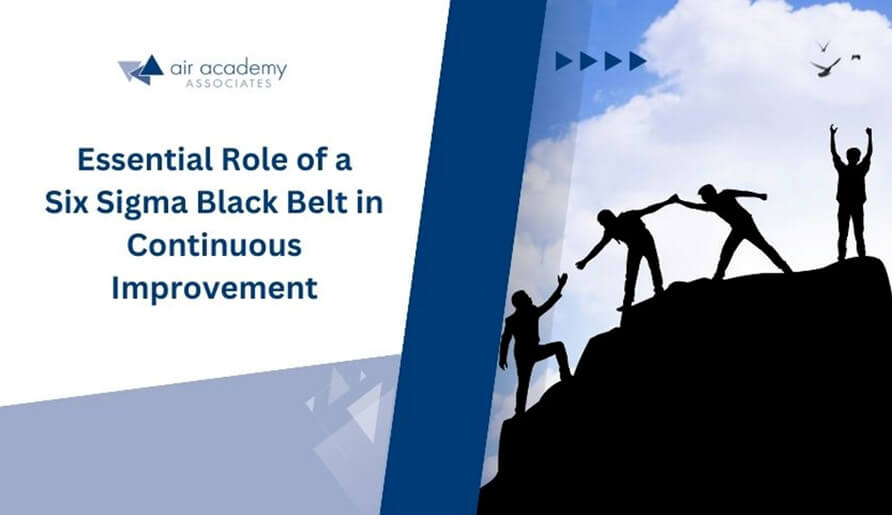
Six Sigma has become one of the most widely adopted quality management programs by leading organizations worldwide. At the core of the methodology are Six Sigma Black Belts – the leaders who execute projects and drive strategic improvements across key processes and systems. This comprehensive guide will explore the critical roles, qualities, and responsibilities that make Black Belts invaluable assets to quality-focused organizations.
Six Sigma Black Belt – An Overview
A Six Sigma Black Belt is a technical expert and project leader within an organization’s Six Sigma program. They take responsibility for leading complex process improvement projects that require advanced statistical skills and quality management knowledge.

Image Source: Wikimedia Commons
Black Belts guide cross-functional teams to achieve significant enhancements in metrics like defect reduction, increased efficiency, and cost savings. Their continuous improvement projects align with the organization’s broader quality, performance, and growth objectives.
Motorola created the Black Belt role in the 1980s. The martial arts ranking system inspired the name to represent the highest technical proficiency, similar to a Karate black belt. Today, Black Belts are the backbone of corporate Six Sigma programs across various industries, including manufacturing, healthcare, finance, and technology.
Obtaining a Six Sigma Black Belt certification requires intensive training, passing rigorous exams, and leading complex projects to demonstrate their expertise. We will explore the key qualities and responsibilities that make an effective Six Sigma Black Belt.
The Multifaceted Role of a Six Sigma Black Belt

Image Source: Freerange Stock
Six Sigma Black Belts are experts in statistical analysis and quality management, leaders, mentors, and strategic advisors. They serve as the linchpin in an organization’s quest for excellence, bridging the gap between management’s vision and the team’s execution of process improvements.
Below is an in-depth look at Six Sigma Black Belt’s diverse organizational roles.
Statistical Expert
- Technical Proficiency: Black Belts are well-versed in Six Sigma principles, tools, and methodologies. They are the go-to experts for any technical queries related to process improvement.
- Data-Driven Techniques: They employ a range of data-driven techniques such as statistical process control, regression testing, design of experiments, and hypothesis testing.
- Quantifiable Results: Their expertise enables them to transform raw data into actionable insights, achieving measurable and quantifiable results that align with organizational goals.
Project Leader
- DMAIC or DMADV Frameworks: Black Belts lead projects using structured frameworks like DMAIC (Define, Measure, Analyze, Improve, Control) or DMADV (Define, Measure, Analyze, Design, Verify).
- Cross-Functional Team Management: They assemble and manage cross-functional teams, ensuring each member contributes effectively.
- Phase-by-Phase Guidance: Black Belts guides teams through each project phase, from defining objectives to implementing controls, ensuring that milestones are met on time and within budget.
Mentor
- Coaching Green Belts: Black Belts play a crucial role in developing the next generation of Six Sigma practitioners by coaching and mentoring Green Belts.
- Team and Stakeholder Education: Beyond Green Belts, they also educate team members and stakeholders on the importance and application of Six Sigma methodologies.
- Building Organizational Capability: Through their mentorship, Black Belts help to instill a culture of continuous improvement within the organization.
Change Agent
- Advocacy for Improvement: As change agents, Black Belts are vocal advocates for continuous organizational improvement.
- Cultural Adoption: They work to break down barriers and resistance to change, facilitating the cultural adoption of Six Sigma principles.
- Removing Obstacles: Black Belts identifies and eliminates obstacles that may hinder the successful implementation of process improvements.
Strategic Advisor
- Alignment with Objectives: Black Belts work closely with senior management to ensure that Six Sigma projects are aligned with the organization’s strategic objectives.
- Quality Goals Execution: They translate management’s quality goals into actionable projects.
- Resource Allocation: As strategic advisors, they may also recommend resource allocation to ensure that projects are adequately supported.
Qualities of a Six Sigma Black Belt
Six Sigma Black Belts are highly trained professionals in the Six Sigma methodology, which focuses on improving processes and reducing defects. However, being a Black Belt is not just about having statistical and quality management expertise; it also requires a balanced set of hard and soft skills.

Image Source: PXHERE
Below is an expanded outline detailing the essential qualities that make an effective Six Sigma Black Belt.
Leadership Skills
- Manage Teams: Black Belts often lead cross-functional teams. They must be adept at assigning tasks, setting goals, and ensuring everyone is aligned with the project objectives.
- Facilitate Collaboration with Empathy: They must create an environment where team members feel comfortable sharing ideas. Empathy helps in understanding team dynamics and resolving conflicts.
Communication Skills
- Synthesize Complex Data into Insights: Black Belts deal with large data sets and complex processes. They must be able to distill this information into actionable insights that team members and stakeholders easily understand.
- Influence Stakeholders: Effective communication is crucial when presenting findings and recommendations to senior management to gain approvals and buy-in.
Problem-Solving Skills
- Quickly Diagnose Root Causes: Using tools like Fishbone diagrams or the 5 Whys technique, Black Belts should be able to identify the underlying issues affecting a process quickly.
Business Acumen
- Understand the Organization’s Objectives and Functions: A Black Belt should have a deep understanding of the business landscape, including the organization’s mission, vision, and strategic objectives, to align the Six Sigma projects accordingly.
Change Management Skills
- Motivate Adoption of New Processes: Black Belts must be skilled in change management to ensure that new processes and improvements are adopted smoothly across the organization.
Critical Thinking
- Objectively Analyze Situations and Apply Solutions: Critical thinking involves evaluating information and situations impartially. Black Belts must be able to dissect a problem and choose the most effective course of action.
Data-Driven Approach
- Leverage Statistical Tools to Make Decisions: Six Sigma heavily relies on data. Black Belts should be proficient in using statistical tools like Minitab or SPSS to analyze data and make informed decisions.
Organizational Skills
- Scope and Plan Projects Effectively: Good organizational skills are essential for scoping, setting timelines, allocating resources, and keeping the project on track.
Responsibilities of a Six Sigma Black Belt

Image Source: Flickr
Six Sigma Black Belts is crucial in driving an organization’s process improvements and operational excellence. Their responsibilities span various stages of a project lifecycle, from initial scoping to execution and result analysis. Here’s an in-depth look at the multifaceted roles they play:
Project Scoping
- Identify Improvement Opportunities Aligned with Organizational Goals: One of the first tasks for a Six Sigma Black Belt is identifying areas where improvements can be made. These opportunities should be aligned with the organization’s strategic goals to ensure the project will have a meaningful impact.
- Conduct a Cost-Benefit Analysis to Build a Business Case: Before diving into a project, it’s essential to weigh the costs against the benefits. A detailed cost-benefit analysis helps build a strong business case for the project, justifying the resources and time invested.
- Clearly Define Goals, Boundaries, Resources, and Stakeholders: A well-defined scope sets the stage for a successful project. This involves outlining the project’s goals, setting boundaries, identifying the necessary resources, and recognizing the stakeholders involved.
- Create Detailed Project Charters and Plans: A project charter is a formal document outlining the project’s scope, objectives, and stakeholders. Detailed project plans then break down the steps needed to achieve these objectives.
Analyzing Processes
- Gather Performance Data and Map Out Current Processes: Understanding the current state is crucial for any improvement project. This involves collecting data on existing processes and mapping them out to identify bottlenecks or inefficiencies.
- Utilize Statistical Tools like Capability Analysis and DOE (Design of Experiments) to Analyze Pain Points: Advanced statistical tools dig deeper into the data to identify the root causes of problems. Capability analysis helps in understanding the performance of processes, while Design of Experiments (DOE) can be used to test various factors affecting a process.
- Validate Root Causes with Data-Driven Techniques: Once potential root causes are identified, they must be validated using data-driven methods to address the right issues.
Leading Teams
- Manage and Motivate Cross-Functional Teams: Black Belts often lead teams with members from different departments. Effective management and motivation of these cross-functional teams are vital for the project’s success.
- Assign Clear Roles and Responsibilities: Each team member should know their role and what is expected of them. This clarity helps in the efficient execution of tasks.
- Provide Coaching and Development for Members: As leaders, Black Belts also help team members develop their skills and knowledge.
- Foster Collaboration Between Departments: Encouraging a collaborative culture helps break down silos and improve processes more effectively.
Executing Improvements
- Design Improved Processes, Systems, and Products to Address Issues: The next step is to design solutions once the problems are identified and validated. This could involve tweaking existing processes or creating entirely new ones.
- Standardize Solutions and Establish New Controls: After testing the solutions, they must be standardized across the organization. New controls are established to maintain these improvements.
- Manage Change Management Activities like Training: Implementing new processes often requires changing behavior and skills. Black Belts manages the training and other change management activities to ensure a smooth transition.
Driving Results
- Apply Statistical Analysis to Verify and Validate Improvements: The effectiveness of the solutions is verified through statistical analysis. This ensures that the changes are yielding the desired improvements.
- Quantify Performance Gains, ROI (Return on Investment), and Savings: The project’s success is measured in tangible terms like performance gains, ROI, and cost savings.
- Report Progress to Executives and Stakeholders: Regular updates are provided to senior management and stakeholders to inform them about the project’s status.
- Implement Solutions Across the Organization: Once proven successful, the solutions are rolled out to maximize benefits.
Mentoring Green Belts
- Guide Projects Within Their Function: Black Belts often mentor Green Belts, who are less experienced in Six Sigma methodologies. They guide them in managing smaller projects within their functional areas.
- Teach the Use of Six Sigma Tools and Problem-Solving Techniques: Part of the mentoring process involves teaching Green Belts about the various tools and techniques used in Six Sigma.
- Review Analysis and Coach Team Leadership Skills: Black Belts review the work done by Green Belts and provide coaching to improve their leadership and analytical skills.
Advancing Six Sigma Culture
- Promote Adoption Through Training and Leadership Commitment: For Six Sigma to be effective, it has to be part of the organizational culture. Black Belts promotes this culture by training employees and securing a commitment from leadership.
- Contribute Ideas to Improve the Overall Program: Continuous improvement is a cornerstone of Six Sigma. Black Belts contributes to this by constantly developing ideas to enhance the program.
- Motivate Continuous Improvement Culture: Lastly, Black Belts are champions of change, always motivating teams and the organization to strive for continuous improvement in processes and results.
Conclusion
Six Sigma Black Belts are invaluable assets to quality-focused organizations in manufacturing, healthcare, banking, and technology. They lead strategic projects that enhance efficiency, reduce costs, and boost stakeholder value.
With their technical proficiency, change management skills, and hands-on application, Black Belts function as linchpins between executive direction and team execution. They identify improvement opportunities, mentor Green Belts, and implement data-driven solutions to complex business challenges.
Professionals who obtain Black Belt certification and gain experience applying Six Sigma can unlock immense career advancement opportunities. The future demand for these process improvement experts remains strong.
Take your professional skills to the next level with Air Academy Associates’ Lean Six Sigma Black Belt online course. Master the art of process improvement and become an invaluable asset to your organization.


